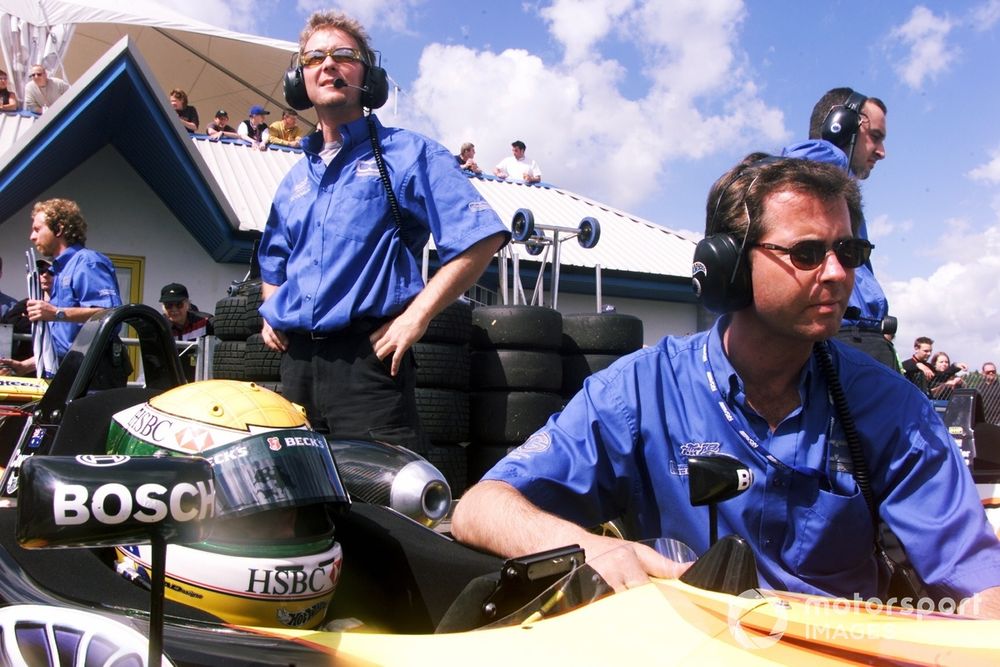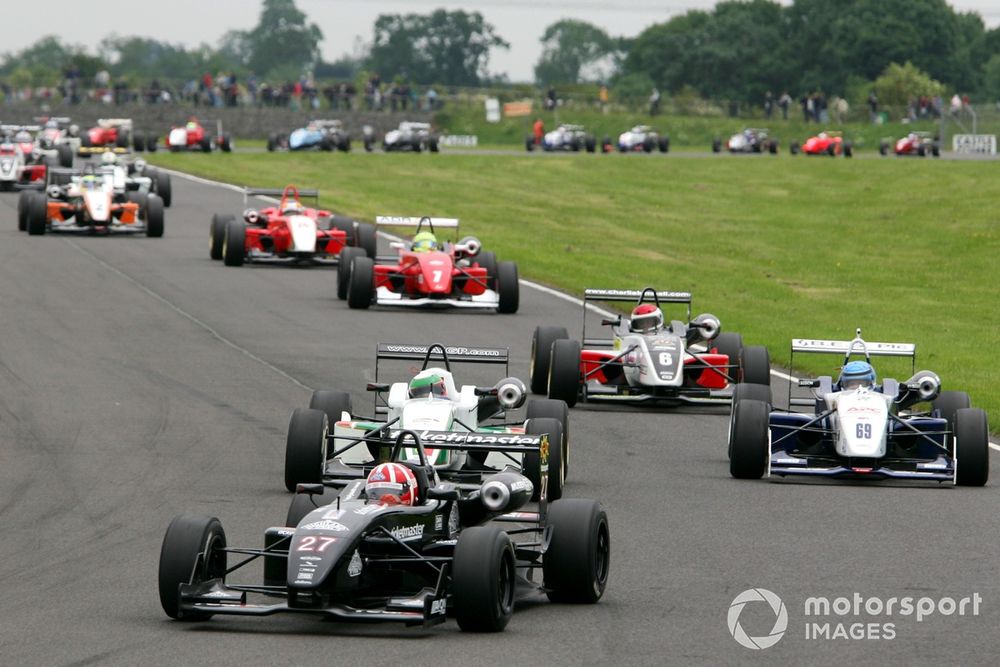The date is 26 June 2005. When a puncture causes Charlie Kimball to spin out of second place and incites red flags, his Carlin team-mate Alvaro Parente is confirmed as the winner of the final British Formula 3 International Series race held at Castle Combe. One month later, the Wiltshire circuit loses its appeal against a noise abatement order, signalling the end of a five-year run in which its British F3 and British GT meetings proved popular with fans and entrants alike.
“We always looked forward to going there,” confirms Trevor Carlin, whose eponymous squad won six times at Combe between 2001 and 2005. No other team managed more than one. “It had a lovely atmosphere to it and of course we were the main event, so it got good crowds.”
Carlin calls the 1.85-mile track, which celebrates its 75th anniversary this year with the Autumn Classic festival in September, “an epic driver’s circuit” that rewarded full commitment and precision. You don’t have to look hard for drivers that agree.
With laptimes completed in under a minute (Dan Clarke’s 2005 lap record of 59.387 seconds was only beaten in 2021 by F3 Cup racer Stefano Leaney’s Dallara F317 at 58.596s), action was fast and frenetic. Just how Adam Carroll likes it.
“Even the [Esses and Bobbies] chicanes, each part of the track is flowing,” relates the Ulsterman, who followed up two Scholarship class victories in 2002 with four outright podiums in 2003-04 driving for Menu Motorsport and P1 Motorsport. “The last chicane even has a nice little compression. They’re not just straightforward, boring modern chicanes.”
Pinpoint accuracy here was crucial to avoid clouting floppy markers that could easily damage the front wing or become lodged in the front suspension and wreck the handling. Getting close to the tyre stacks on the approach could also yield time but Parente, who admits to having hazy memories of the 2005 triumph in a title-winning season he claimed 11 victories, has no trouble recalling his first visit to Combe when he discovered these were fairly inflexible.
“In one of the chicanes, I clipped the tyre wall and I broke the front-left suspension,” the Portuguese says of a test aboard a Carlin-run Formula BMW chassis to learn the track. “Trev and the guys weren’t happy!”
Parente adored Caste Combe for its unforgiving but thrilling challenge
Photo by: Sutton Images
Both Parente and Carroll reserve special praise for the hair-raising final turn passing the waist-height pitwall, a right-hand sweeper called Camp. “Almost flat in the Formula 3 or just a lift on the entry and then back on the throttle”, according to Parente, it afforded little room for error on the exit as drivers sought to use all the road available. Famously, it caught out dominant leader Danny Watts in 2003. To Carroll, Camp was “your perfect Formula 3 corner”, with track limits not up for debate…
“Everyone would stand there,” relates Parente, who broke his British F3 duck at a wet Combe with Carlin in 2004 after jumping poleman Carroll. “I remember [with] the brave ones, it was impressive to watch through there. For myself also it was a nice corner, very tricky.”
“If you went off, you were having a big one, the runoff was minimal,” asserts Carroll. “The entry speed and the nature of it meant it was always a fine line; you could keep edging into it but you needed to be careful.”
The first F3 meeting held at Combe in 30 years was a journey into the unknown for everybody. “No F3 cars had even done laps around there,” says Carlin, though he didn’t need much convincing when late circuit boss Howard Strawford engaged veteran racer Ian Flux to lobby teams on its behalf for inclusion on the calendar: “We liked the idea, because it was an hour and a half from where we were, so it was easy to get to. And we like fast tracks!” Anthony Davidson breezed to a pair of wins, defeating team-mate Takuma Sato.
“It doesn’t matter what circuit you go to or the facilities, as long as it is great to drive, that’s all that matters really. It was a very enjoyable circuit” Adam Carroll
After Robbie Kerr (Alan Docking Racing) beat title rival James Courtney in 2002’s opener, the Carlin driver looked set to punch back in race two until he was penalised for creeping at the start. Courtney’s team-mate Alan van der Merwe secured his maiden victory with a spectacular move around the outside of the bumpy Quarry right-hander on Promatecme’s Bruce Jouanny.
“It was fantastic,” agrees Carlin. “Bruce was an absolute gentleman and you knew he wouldn’t put him in the barrier. But he could have… If it had been a different driver, that would have been a supremely brave move. As it was, Alan knew his competitor and took the chance.”
After his Camp rotation handed champion-elect van der Merwe victory over Carroll in the 2003 opener, Hitech’s Watts made amends by blitzing race two, then made history on his return in 2004 when his Promatecme-run Lola-Dome ended Dallara’s 11-year stranglehold on the category. As in 2003, Nelson Piquet Jr crashed out at Camp.

Carlin, pictured with Courtney, backed the idea of bringing British F3 to Castle Combe
Photo by: Sutton Images
Although a new media and hospitality centre was introduced for 2004, Combe was increasingly resembling an outlier on a progressively international calendar that by 2005 included Spa (although the races were cancelled due to fog), Monza and the Nurburgring.
“Let’s be honest, the facilities were basic,” Carlin says. “It was right on the edge of clubbiness, a bit like Croft in a way.”
That said, the variety of its tracks was central to the championship’s charm. “Each track was very special and that’s why it was so great to do British Formula 3,” concurs Parente, who followed Double R’s Clarke home in the first race of Combe’s final F3 meeting. “It was a bit of a mix. Castle Combe with those improvised chicanes and last corner, it was special, but it wasn’t the only one that was like special like that. We had a very interesting calendar, didn’t we?”
There is an argument that the noise ruling only hastened the inevitable, as British F3 sought to broaden its appeal by adding more overseas fixtures. The Pau Grand Prix counted for British championship points in 2006, the same year Mugello swapped in for Monza. By 2007, British F3 was racing on the streets of Romania’s capital, Bucharest. But for Carlin, it is moot as the championship fell victim to the FIA’s desire to consolidate F3-level categories under its control. “If Combe had still been on the calendar, it would have disappeared anyway,” he says.
Two decades have now passed since Castle Combe last hosted a fully-fledged international single-seater contest. Formula Palmer Audi paid a visit in 2007, but the MSV-run series wasn’t pitched in the same field as British F3. Although loyal members of the local Castle Combe Racing Club continue to turn out in Formula Fords, it is a shame that the venue has largely been bypassed by a generation of drivers with ambitions of reaching motorsport’s highest echelons. Absent from the TOCA tour, with British Formula 4 taking in visits to Knockhill, Thruxton and Oulton Park this year, Combe is “unfairly” overlooked as a hidden gem of British motorsport according to Carlin.
Carroll is glad to have had the opportunity to refine his skillset there, where many in subsequent years have not. “It doesn’t matter what circuit you go to or the facilities, as long as it is great to drive, that’s all that matters really,” he contends. “It was a very enjoyable circuit [in F3] and if people were to go and race there, I’m sure most people would enjoy it.”
Parente holds the same view and believes circuits of Combe’s ilk are sorely missed on single-seater calendars that increasingly include copy-paste Grand Prix tracks. “For example, [at Paul] Ricard, if you take a little bit too much speed, you just open the steering, go a bit wide, and it’s fine,” he says. “That doesn’t really happen in in Castle Combe. If you take a bit too much on those chicanes, you damage the car and that’s race over. Of course, you miss that a bit.”
The circuit’s contribution to shaping a generation of talent that would go on to Formula 1, IndyCar and beyond is largely unappreciated. But amid the nostalgia of its big birthday celebrations, they are certainly worth remembering.

Castle Combe remains a favourite fixture in the national racing scene, even if its days hosting top-level junior motorsport are fleeting
Photo by: Sutton Images
In this article
Be the first to know and subscribe for real-time news email updates on these topics
Subscribe to news alerts
Read the full article here

